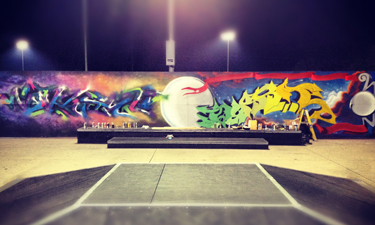 Graffiti has long been a menace to public parks, viewed as vandalism more than art, as it appears unsolicited on walls, benches or buildings. But a program at one park is putting spray cans into the hands of teens, teaching them how to legally use them as a form of expression.
Graffiti has long been a menace to public parks, viewed as vandalism more than art, as it appears unsolicited on walls, benches or buildings. But a program at one park is putting spray cans into the hands of teens, teaching them how to legally use them as a form of expression.
“I’m a real proponent of graffiti art within the community in a legal way,” says Alec McDowell, manager of Wakefield Skate Park in Annandale, Virginia. “I wanted to give the kids a way to practice their skills with a real artist.”
The park program isn’t the first to view graffiti through a new lens. Creating spray-paint murals is one of the methods suggested by the nonprofit Project for Public Spaces to prevent graffiti vandalism on public property.
Research suggests multi-colored mural projects can help discourage unwanted graffiti or “tagging,” an elaborate signature left by the artist. Such projects help build a sense of ownership among participants and remove the blank canvases that would otherwise tempt graffitists.
McDowell first tapped visual artist Dan Roncesvalles earlier this year to bring some color to the skatepark, which sits just outside Washington, D.C.’s Beltway and is run by the Fairfax County Park Authority. Roncesvalles brought in another artist to help him scrawl psychedelic letters along both sides of a full moon, an expansive and fitting backdrop for the skatepark.
McDowell liked the work so much that he asked the park authority to allow Roncesvalles to teach students, ages 12 to 17, how to legally practice graffiti art through a five-week course. The program launched in late June with a handful of participants and will be continued quarterly.
Learning the Hard Way
Growing up in the 1990s in Washington, D.C., Roncesvalles taught himself the art of graffiti, often practicing on not-so-legal surfaces.
“If you’re in it for a long time, you’ve already experienced that sort of thing,” Roncesvalles says about getting in trouble — rather than recognized — for his art. “You become smarter. You want to paint stuff, but you want to find more legitimate avenues to express the art form.”
Roncesvalles’ portfolio now includes several city murals and gallery projects. He has painted whimsical letters for the City of Rockville in Maryland and helped nearby Herndon, Virginia, depict its history à la spray paint on a wall in town.
He’s also involved with the Murals D.C. Project, which has curated more than 30 pieces of art across the city to reflect its character, culture and history. The project focused on areas with particularly high incidents of illegal graffiti and has been a successful deterrent.
Roncesvalles says the murals, which often depict more scenes and people than the lettering typically associated with graffiti, have helped people to realize that art “can be achieved with spray paint, as an actual medium.” He’s seen that message spread in urban areas and would like to see more well-executed graffiti projects in the suburbs and in public spaces.
“If murals were done properly, they wouldn’t dismiss it as graffiti. People would see it as a legitimate art form,” he says.
McDowell remembers the first time he saw graffiti art displayed prominently in a city space. It struck him as “a gift for everyone to see.”
Learning Slowly
Students in the beginner class start out with pen and paper, working with Roncesvalles on their tags for the art they will eventually create.
“It’s not just taking the spray can and taking it to the board,” McDowell says. “There’s so much control involved with the way you push down, the amount of pressure you use on the can.”
First attempts can easily turn into runny messes, despite how easy the pros make it look. McDowell says parents have been pleased with the program, which so far has attracted art-minded teens. He’s considering expanding the classes to include adults.
McDowell plans to follow up the paper-and-pen sessions with a higher-level class that will give the burgeoning artists more time to work with paint. Eventually, he’d like to see their art displayed in the skatepark or other spaces.
Maybe he’ll even commission it.
Whitney Pipkin is a freelance journalist and editor in northern Virginia.

